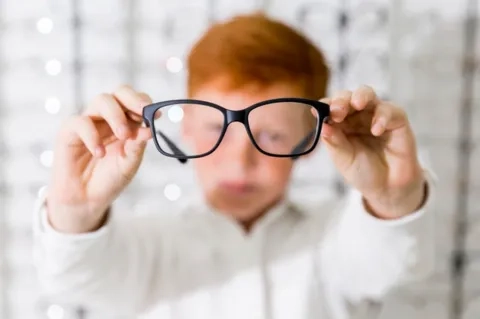Tips for choosing spectacles if your child is diagnosed with myopia

Healthy eyes and good vision play a vital role in your child’s learning and development. If the day comes when your child is required to wear spectacles to aid in vision clarity, it is of great importance to choose a suitable and comfortable frame for the child upon a proper eye examination by the ophthalmologist or optometrist.
Prescription strength
The lenses prescription is always the primary consideration in choosing the frame. If the prescription is high, the ophthalmic lenses are likely to be thick. As such, avoid large frames that will increase the thickness and weight of the lenses.
With technology advancements, thinner lenses are also an alternative option although it may be more expensive. One thing to note is that with high power lenses, peripheral vision can still be distorted regardless of the lens thickness selected.
Frame size

Ensure that the selected spectacle frame is suitable and fitted for your child. It should be neither too big nor too small, so that the frame will rest well on your child’s nose. It is also important that the spectacles do not sit on the child's cheeks which can cause pressure marks and discomfort.
Full-rim frames are favoured over half-rim or rimless as they are more robust and easier to care for. A gentle reminder to avoid buying spectacles that are larger, expecting your child to grow into them as this will affect both the comfort level and vision clarity of your child.
Frame material
The materials used for the spectacle frames are generally made of metal or plastic (in various types). Metal frames will usually come with adjustable nose pads so that it can be adjusted to ‘sit’ nicely on the nose bridge. In the past, plastic frames did not have adjustable nose pads but with new innovation and high demand, there are many designs that now come with nose pads.
Both metal and plastic frames that are lightweight and cater to children will work well.
However, if your child has shown allergy towards certain metal alloys for e.g. nickel which can be present in metal frames, it is advisable to select frames that are made of hypoallergenic materials such as titanium instead.
Nose bridge
The nose bridge for your child's spectacles should have a wide contact surface so that the weight of the spectacles is evenly distributed. It needs to rest properly on the nose and not slide down easily, otherwise it will cause your child to look over the top of the frame instead of looking through the lenses. The spectacles should not sit too close to the eyes and lashes either as that can cause the lenses to fog up or smudge easily.
Temples
The frame temples should not cause uncomfortable pressure at the sides when your child is wearing the spectacles. Cable temples that wrap all the way around the back of the ears are available to help to keep spectacles from sliding down. Certain frame designs that include an elastic strap that goes around the head will work well for young children to keep the spectacles from falling off the face.
Temples with spring hinges are recommended as this increases the temples flexibility and ability to flex outward without causing any damage, while your child is putting on and removing the spectacles.
Lens material

Main priority for the ophthalmic lenses is eye safety. This has to be the most important consideration when making a decision for the lens material to avoid possible safety hazard.
The 2 main materials used for lenses are mineral glass and ÇR-39 plastic. Glass lenses should never be prescribed for children as they are heavier, can break and shatter very easily so it is considered as high risk to children. Plastic lenses, on the other hand, are lighter and do not break as easily. Hence, it is more advisable for a child’s usage.
There are more material choices available for children nowadays such as polycarbonate and Trivex lenses. These type of lenses are even lighter and more impact resistant as compared to plastic lenses.
Protection against ultraviolet (UV) rays in the lenses is highly recommended as an added protection since your child will be wearing his/her spectacles quite often. It is also possible to have a scratch resistant coating on the lenses to prolong the usage due to wear and tear.
A ‘Back-up’ pair
Children tend to be very active and can be rough and break their spectacles at times. It may be a good idea to purchase a second, or backup pair of spectacles for your child, particularly if the child has a high prescription and cannot see well without spectacles.
Last but not least, patience will be needed when buying and selecting the right spectacles for your child. Always check with the optometrist or optician when in doubt.
Advocation of good eye care habits is still necessary whether or not your child is wearing spectacles. By teaching your child how to take care of his/her eyes and pursuing good vision through the use of spectacles is a life lesson that will stick with them forever.
References:
- Kids Eye Wear. All About Vision website. https://www.allaboutvision.com/buysmart/kidseyewear.htm
- The Right Spectacle Frames For Children. Zeiss website. https://www.zeiss.com.sg/vision-care/better-vision/health-prevention/the-right-spectacle-frames-for-children-.html
- How to Choose the Right Spectacles for your Children. Singapore Motherhood website. https://singaporemotherhood.com/articles/2018/09/spectacles-children-myopia-vision/
Recent Blog Posts
- 19 Oct 2022
- 19 Oct 2022
- 19 Oct 2022
- 19 Oct 2022
- 19 Oct 2022
